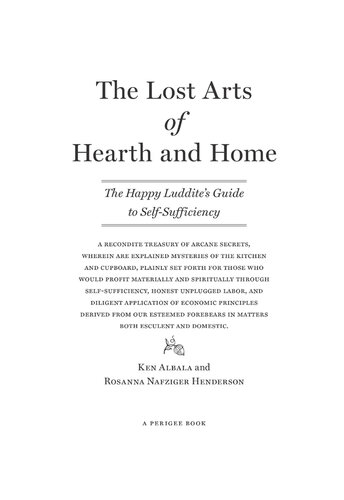
The Lost Arts of Hearth & Home
The Happy Luddite's Guide to Domestic Self-Sufficiency
کتاب های مرتبط
- اطلاعات
- نقد و بررسی
- دیدگاه کاربران
نقد و بررسی

October 1, 2012
Albala and Henderson follow up their The Lost Art of Real Cooking with an utterly charming collection of recipes and how-tos for the 21st-century hipster homemaker. Like postmodern Elizabeth Davids, they augment their own recipes with obscure, intriguing ones from earlier centuries, such as Apicius’s fourth-century Apricot Minutal, which stews up the fruit with spices and garum, an ancient fish sauce. The book consists mostly of recipes—albeit for unusual, slow-food, and occasionally bizarre dishes such as injera (Ethiopian sourdough pancakes), liverwurst, thousand-year-old eggs (“among the scariest things I have ever tried at home”), kombucha, and butter sauce with ambergris (yes, the “waxy glob that forms in the intestines of sperm whales, which they barf up”)—but, like a quirky updated 1896 Fannie Farmer cookbook, it also includes eccentric but usable household hints and instructions, from soap-making to pounding a ring out of an old silver quarter (using an expedited method invented by Henderson’s father). A fun gift for any curious reader, the book is a must-have for makers and urban homesteaders.

February 1, 2013
Albala (history, Univ. of the Pacific) and Henderson (coauthor with Albala, The Lost Art of Real Cooking) here tackle household projects both comestible (brewing, preserving) and not (rug braiding, hammering silver quarters into wedding rings, making one's own broom). Despite the depth and breadth of topics covered here, the book is not for homesteaders or those heading for a life off the grid. The intended audience is city dwellers or suburbanites whose time is limited but who want to regain a measure of self-sufficiency over their domestic lives by making some of the objects they use and foods they consume and who want to have fun doing so. Recipes are written in an informal, narrative format, rather thanproviding the standard list of ingredients followed by directions. The projects range from familiar items like sourdough bread and liverwurst to more unusual ones like Acorn Crepes, Jasper of Milk, and something known, mysteriously, as Pig Jam. The authors also explore ingredients and animal parts used infrequently in American kitchens, such as gingko nuts and chicken feet. VERDICT The project instructions are clear and easy to follow and there's quite a lot of humor in the text. Recommended for anyone interested in learning new domestic skills.--Stephanie Klose, Library Journal
Copyright 2013 Library Journal, LLC Used with permission.

























دیدگاه کاربران